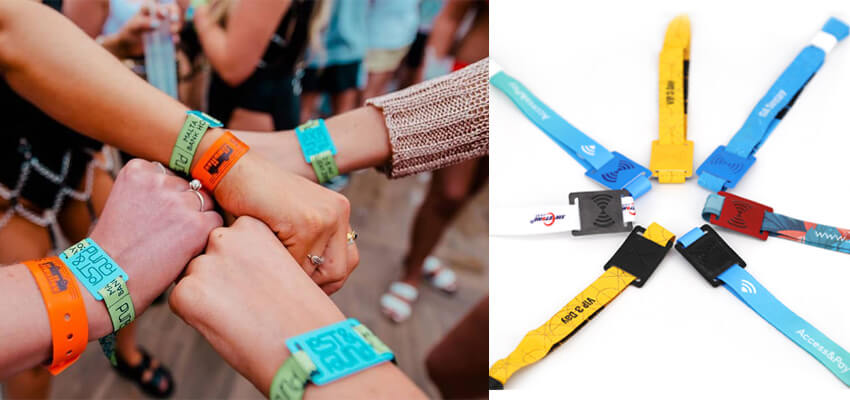- Home
- Blog
- About
- FAQ
- RFID Cards View All
- Wristbands
- Custom View All
- Contact
Do you know what is RFID wristband? And how do RFID wristbands work?
We may have worn RFID wristbands while attending grass festivals, watching outdoor concerts, going to exclusive spas, and more. At some big hotels, getting in and out of a room is no longer a smart card, but a wearable RFID wristband.

Learn about How do RFID wristbands work?
We receive lots of questions about RFID wristband technology at RFIDSilicone.com, like how it works and what the benefits are for event organizers, etc. So, we would like to briefly explain the working principle and related technical knowledge of RFID wristbands here. I hope to help you understand the RFID wristband and RFID industry.
RFID stands for radio frequency identification, but what exactly is it?
RFID refers to a technology of radio frequency identification in which digital data encoded by an RFID wristband or RFID tag (any RFID-enabled object) is captured by an RFID reader via radio waves. This technology enables expert readers or "scanners" to capture data on RFID tags and transfer them to back-end computer systems without contact.
What happens when an RFID wristband tag is read (scanned)?
When reading, the RFID reader will send a coded radio signal to identify the RFID tag. In less than a millisecond, the RFID tag receives the transmission and responds with a unique identification number.
Are RFID wristbands the same as barcode wristband?
Although the principle of obtaining data by scanning is the same, RFID and barcode are completely different. Take a look at the table to compare the differences.
What does an RFID wristband consist of?
The RFID wristband contains a "smart tag" consisting of an RFID chip and an antenna, and different substrates. RFID tags can be in the form of small PVC smart cards, or they can conceal or embed other wristband materials, such as RFID silicone bracelet, RFID cloth wristband, and RFID leather wristband.
There are three types of tags that can be used: passive, active, and battery-assisted.
Passive RFID tag wristband: Passive RFID tags use the energy transmitted by the reader to obtain energy, and there is no built-in battery. Passive is the most popular large outdoor event and venue.
Active RFID tags: Active RFID tags have a battery that transmits information regularly and does not require a reader.
Battery-assisted RFID tags: This RFID tag contains a battery that powers the tag only when the tag is close to the reader.
The reading range that the RFID wristband can satisfy is conditional. Depending on the type of event or festival you plan, you can choose from low frequency to ultra-high frequency.
How much data can RFID wristbands store?
You'll find the types of data stored on RFID tags include authentication, purchase points, coupons, access control to hotels or VIP areas, and even social media information. These types of information usually don't require much data to save.
The biggest passive RFID tag can store 3720 bytes or 3.72 kilobytes of information. This is sufficient to store personal data such as someone's name, address, credit card authorization, and identity information.
UHF tags can store 8 kilobytes of information. For access control systems, RFID tags are typically 3 kb or less.

What data can RFID wristbands collect?
Using RFID technology, organizers can analyze in real time how the wearer moves and interacts with your event, venue or attraction. Highlight peak hours, queue times, and popular attractions. To help you continually adjust and adapt to optimize the experience for your visitors.
Can RFID wristband be used as a tracking device?
Most RFID wristbands use passive high-frequency tags that can only be used over short distances, so they cannot track the location of the wearer. However, RFID can record a person's last location. This is very important and useful information for understanding the traffic flow and safety risks in future events.
Improve every aspect of your event, hotel or attraction
RFID technology not only helps streamline entry procedures, but also connects you to your audience to the next level. Customers no longer need to bring wallets, tickets and personal information to participate. People wearing RFID wristbands can enjoy the show freely. Join with RFID technology. You can contact us to learn more and improve your event experience.
Benefits of RFID technology for events
Due to the security, cost savings and increased revenue benefits of RFID wristband technology, many organizers have introduced RFID technology applications to optimize their activities. Since 2011, the live music festival industry has extensively used RFID technology wristbands at concerts to improve the fan experience, increase safety, and open up new sources of income.
Benefits of RFID wristbands include:
Decrease the queue
Stop theft and fraud
Build better connections with sponsors
Payment cashless
Increase the participation of field participants
Create an experience
Collect real-time analytics
Streaml